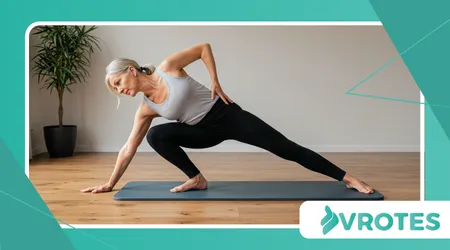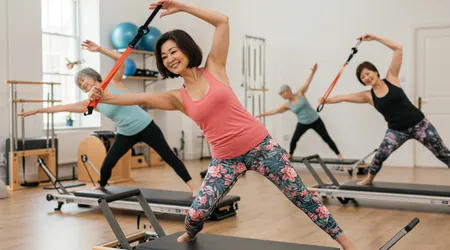Pilates Moves to Alleviate Menopause-Related Back Pain

Pilates moves to alleviate menopause-related back pain offer a gentle yet powerful solution for women navigating the physical challenges of midlife.
Menopause, a transformative phase typically occurring between ages 45 and 55, brings hormonal shifts that can disrupt physical and emotional well-being.
Declining estrogen levels often lead to reduced bone density, muscle loss, and inflammation, which can manifest as persistent back pain.
For many women, this discomfort feels like an uninvited guest, lingering and disrupting daily life. Pilates, with its focus on core strength, flexibility, and mindful movement, emerges as a beacon of relief.
This article explores how pilates moves to alleviate menopause-related back pain can empower women to reclaim comfort and vitality, backed by science and practical insights.
Why let back pain define your midlife when you can move with grace and strength?
The beauty of Pilates lies in its adaptability, making it ideal for midlife women seeking low-impact exercise.
Unlike high-intensity workouts that may strain joints, Pilates emphasizes controlled movements that strengthen the body without overwhelming it.
Research published in the Journal of Exercise Rehabilitation (2016) found that an 8-week Pilates program significantly reduced menopausal symptoms, including physical discomfort, while improving lumbar strength and flexibility.
This evidence underscores Pilates’ role in addressing back pain caused by menopause-related changes.
By targeting core muscles, improving posture, and enhancing spinal mobility, pilates moves to alleviate menopause-related back pain offer a holistic approach to wellness.
Let’s dive into how these movements work and why they’re a game-changer for midlife women.
Pilates isn’t just exercise it’s a mindful practice that reconnects you with your body. During menopause, hormonal fluctuations can weaken the pelvic floor and spine-supporting muscles, exacerbating back pain.
Pilates moves to alleviate menopause-related back pain counteract these effects by fostering alignment and stability.
Imagine your body as a house: without a strong foundation, the walls crumble. Pilates rebuilds that foundation, brick by brick, through precise, intentional movements.
This article will guide you through specific exercises, practical tips, and the science behind why Pilates is a midlife woman’s ally in combating back pain.
Why Menopause Triggers Back Pain
Menopause brings a cascade of changes, many of which target the spine. Estrogen decline reduces bone density, increasing osteoporosis risk and spinal stress.
Muscles weaken, and inflammation spikes, causing stiffness and discomfort in the lower back. These shifts can make everyday tasks like bending or sitting feel daunting.
The lumbar spine, a common pain point, bears the body’s weight. Hormonal changes weaken supporting muscles, leading to poor posture and strain.
++ Gentle Strength Training Routines to Protect Bone Density
Pilates moves to alleviate menopause-related back pain strengthen these muscles, reducing pressure on the spine. They also combat inflammation, a key pain driver.
Beyond physical changes, menopause can disrupt sleep, amplifying pain perception. Stress and mood swings further tense muscles, worsening back issues.
Pilates’ mindful breathing and focus help calm the nervous system, easing tension. This dual approach physical and mental makes Pilates uniquely effective.

How Pilates Targets Back Pain in Menopause
Pilates strengthens the core, the body’s powerhouse, supporting the spine. Pilates moves to alleviate menopause-related back pain focus on the transverse abdominis and pelvic floor, stabilizing the lumbar region. These exercises improve posture, reducing strain on overworked muscles.
Unlike aggressive workouts, Pilates is low-impact, ideal for menopausal women with joint sensitivity. Controlled movements enhance flexibility without risking injury.
For example, the Pelvic Tilt gently mobilizes the spine while engaging core muscles, offering instant relief.
Pilates also promotes circulation, reducing inflammation that fuels back pain. Its emphasis on breathwork lowers cortisol, easing muscle tension.
By addressing both physical and emotional stressors, pilates moves to alleviate menopause-related back pain create lasting comfort.
Also read: Low-Impact Cardio Workouts to Boost Heart Health After 50
The practice fosters body awareness, helping women identify and correct harmful movement patterns. Poor posture, common in menopause, exacerbates back pain. Pilates retrains the body for proper alignment, preventing future discomfort.
Incorporating Pilates into a routine builds resilience. Regular practice strengthens bones, countering osteoporosis risks.
Pilates moves to alleviate menopause-related back pain empower women to move confidently, reclaiming control over their bodies.
Top Pilates Moves for Back Pain Relief
Pelvic Tilt
Lie on your back, knees bent, feet flat. Inhale deeply, then exhale, tilting your pelvis upward, flattening your lower back. Hold briefly, release. This move strengthens the core, easing lumbar strain.
The Pelvic Tilt is a beginner-friendly exercise that mobilizes the spine. It’s like rocking a cradle, gently easing tension.
Perform 8–10 reps for optimal relief. Consistency builds core stability, crucial for menopause-related back pain.
Start with slow, deliberate movements to avoid strain. If discomfort persists, consult a doctor to rule out conditions like osteoporosis.
Pilates moves to alleviate menopause-related back pain like this are safe and effective when done mindfully.
Read more: Aromatherapy Blends to Reduce Menopause-Related Stress
Cat-Cow Stretch
On all fours, inhale, arching your back (Cow). Exhale, rounding your spine (Cat). Flow smoothly between poses. This stretch enhances spinal flexibility, reducing stiffness. It’s a gentle warm-up for midlife bodies.
The Cat-Cow Stretch mimics a cat’s graceful movements, loosening tight muscles. Perform 6–8 cycles, focusing on breath. It’s ideal for morning routines, combating menopausal stiffness.
Pilates moves to alleviate menopause-related back pain like this boost mobility.
Avoid forcing the spine beyond comfort. If you feel pain, reduce the range of motion. Pair this with deep breathing to maximize relaxation and pain relief.
Bridge
Lie on your back, knees bent, feet hip-width apart. Exhale, lifting hips toward the ceiling, engaging glutes. Lower slowly. This strengthens the lower back and core. It’s a powerhouse move for stability.
Think of the Bridge as building a sturdy bridge over a river, supporting your spine. Do 10–12 reps, holding each lift for 3 seconds. It counters menopausal muscle loss effectively.
Ensure knees stay aligned with hips to avoid strain. Pilates moves to alleviate menopause-related back pain like the Bridge promote strength without overloading joints. Consult an instructor for personalized guidance.
Spine Stretch Forward
Sit with legs extended, feet flexed. Inhale, lengthening spine; exhale, rounding forward, reaching toward feet. Return slowly. This stretch relieves lower back tension. It’s perfect for desk-bound women.
The Spine Stretch Forward is like unrolling a scroll, releasing spinal tightness. Perform 5–7 reps, focusing on smooth articulation. It enhances flexibility, vital for menopausal women.
If hamstrings are tight, bend knees slightly. Pilates moves to alleviate menopause-related back pain like this improve posture, reducing strain. Practice on a cushioned mat for comfort.
Side Leg Lift
Lie on one side, legs straight. Exhale, lifting top leg 6 inches, holding briefly. Lower slowly. This strengthens side glutes, stabilizing the pelvis and lower back. Do 10 reps per side.
Imagine your leg as a lever, reinforcingisier strengthening your core. This move counters menopausal pelvic instability. Pilates moves to alleviate menopause-related back pain like this enhance overall stability.
Use a towel under your hip for comfort. Perform slowly to avoid strain. This exercise builds resilience, helping you navigate menopause with ease.
Integrating Pilates into Your Midlife Routine
Start with 20–30 minutes of Pilates, three times weekly. Pilates moves to alleviate menopause-related back pain fit easily into busy schedules. Choose a quiet space, use a mat, and follow along with a certified instructor’s video.
Consistency is key. Set realistic goals, like completing two sessions weekly, and celebrate small victories. A balanced diet, rich in calcium and vitamin D, enhances Pilates’ benefits. Avoid caffeine to reduce hot flashes.
Joining a group class fosters motivation and community. Online platforms like Lindywell offer tailored menopause workouts. Pilates moves to alleviate menopause-related back pain thrive with expert guidance, ensuring proper form.
For example, Sarah, a 52-year-old teacher, found relief from chronic back pain after three months of Pilates. Her improved posture boosted her confidence, transforming daily activities.
Another example: Maria, 49, struggled with menopausal stiffness. Weekly Pilates sessions, focusing on the Spine Stretch, restored her flexibility. She now enjoys gardening pain-free.
Safety Tips for Practicing Pilates During Menopause
Always listen to your body. If a move causes pain, stop immediately. Consult a healthcare professional if you have osteoporosis or joint issues. Proper form prevents injury.
Start with beginner-level classes to build confidence. Avoid overexertion; menopause can lower recovery rates. Use props like a folded towel for extra support during exercises.
Warm up thoroughly to prepare joints eater and muscles. Cool-down stretches, like Child’s Pose, enhance relaxation. Pilates moves to alleviate menopause-related back pain require mindfulness to be effective.
A certified instructor can tailor exercises to your needs. Online apps, like those reviewed by Reverse Health, offer menopause-specific routines. Always prioritize comfort over intensity.
For women with severe back pain, a physical therapist’s guidance is crucial. Pilates can complement medical care, but never replace it. Stay proactive about your health.
The Science Behind Pilates and Menopause Relief
Pilates reduces inflammation, a key menopause symptom driver. By improving circulation, it alleviates joint pain and hot flashes. Its low-impact nature suits sensitive midlife bodies.
An 8-week Pilates program increased lumbar strength by 20% in postmenopausal women, per a 2016 study. This supports its efficacy for back pain relief.
The practice also boosts mental clarity. Mindful breathing calms the nervous system, reducing stress-related muscle tension. This holistic approach enhances overall well-being.
Pilates strengthens bones, countering menopause-related osteoporosis risks. Weight-bearing moves like the Bridge promote bone density, reducing fracture likelihood.
Regular practice improves sleep quality, a common menopausal challenge. Better sleep lowers pain perception, creating a positive cycle of relief and recovery.
Overcoming Common Challenges

Starting Pilates during menopause can feel daunting. Lack of motivation often stems from fatigue or discomfort. Set small, achievable goals to stay committed.
Physical limitations, like joint stiffness, may discourage practice. Pilates moves to alleviate menopause-related back pain are adaptable; modify as needed with instructor guidance.
Time constraints can hinder regular practice. Short, 10-minute sessions, like those on Pilates apps, fit busy schedules. Prioritize self-care to see results.
Fear of injury is common. Work with a certified instructor to ensure safety. Online platforms offer guided sessions tailored for menopausal women.
Group classes combat isolation, a frequent midlife challenge. Connecting with others boosts accountability. Pilates fosters both physical and emotional resilience.
Table: Benefits of Key Pilates Moves for Menopause-Related Back Pain
| Exercise | Primary Benefit | Reps | Best For |
|---|---|---|---|
| Pelvic Tilt | Mobilizes spine, strengthens core | 8–10 | Lumbar stability |
| Cat-Cow Stretch | Enhances spinal flexibility | 6–8 | Morning stiffness relief |
| Bridge | Strengthens lower back, glutes | 10–12 | Core and pelvic stability |
| Spine Stretch | Relieves lower back tension | 5–7 | Posture improvement |
| Side Leg Lift | Stabilizes pelvis, reduces back strain | 10/side | Balance and hip strength |
Conclusion: Embrace Movement, Reclaim Comfort
Pilates moves to alleviate menopause-related back pain are more than exercises they’re a pathway to empowerment. Menopause may bring challenges, but it also offers opportunities to prioritize self-care.
By strengthening your core, enhancing flexibility, and calming your mind, Pilates transforms how you experience midlife.
The 2016 Journal of Exercise Rehabilitation study confirms its benefits, showing significant improvements in lumbar strength and menopausal symptoms after just eight weeks.
Whether you’re new to Pilates or a seasoned practitioner, these moves can help you navigate menopause with resilience.
Picture your spine as a sturdy tree, its roots strengthened by each mindful movement. From the Pelvic Tilt to the Spine Stretch, pilates moves to alleviate menopause-related back pain rebuild your foundation, easing discomfort and boosting confidence.
Start small, perhaps with a 10-minute session, and gradually increase frequency. Apps like Lindywell or group classes can guide you, fostering community and accountability.
Sarah and Maria’s stories highlight what’s possible: reduced pain, improved posture, and renewed vitality.
Don’t let back pain dictate your midlife. Embrace Pilates as a tool to move freely, sleep better, and feel stronger. With consistency and mindfulness, you can turn menopause into a season of growth.
Why settle for discomfort when pilates moves to alleviate menopause-related back pain can help you thrive? Take the first step today your body will thank you.
Frequently Asked Questions
Can Pilates completely eliminate menopause-related back pain?
No exercise can guarantee complete relief, but pilates moves to alleviate menopause-related back pain significantly reduce discomfort by strengthening core muscles and improving posture. Consult a doctor for persistent pain.
How often should I practice Pilates for back pain relief?
Aim for 2–3 sessions weekly, 20–30 minutes each. Consistency is key to building strength and flexibility, which help alleviate menopause-related back pain.
Is Pilates safe for women with osteoporosis?
Yes, but modifications are needed. Avoid high-impact moves and consult a healthcare professional. Pilates moves to alleviate menopause-related back pain can be tailored for safety.
What equipment do I need for Pilates at home?
A cushioned mat is sufficient. Optional props like a Pilates circle or towel enhance comfort. Apps like Lindywell provide guided routines for home practice.
Can Pilates help with other menopause symptoms?
Yes, Pilates reduces hot flashes, improves sleep, and boosts mood by lowering stress. Its holistic approach supports overall well-being during menopause.
